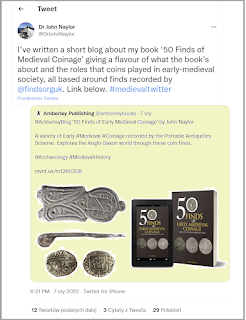A blog commenting on various aspects of the private collecting and trade in archaeological artefacts today and their effect on the archaeological record.
Monday, 10 January 2022
UK Archaeology, One Might Ask, Why?
Dr John Naylor (Ashmolean museum) announces gleefully that he's written a post on a publisher's blog about another book in the PAS "Fifty finds..." fluff series giving a flavour of what his book is about. Dr Naylor's book purports to illustrate "the roles that coins played in early-medieval society, all based around finds recorded by the Portable antiquities Scheme". One might ask "why?" Are these archaeological data? (Spoiler: no). The blog goes on about the partnership between PAS and artefact hunters as a "quiet revolution going on in British archaeology" (sic) and "enormous amounts of new evidence from the distributions of objects across the countryside to the analysis of types of objects, their designs and decorations". The aim is to show: "even the smallest of objects can tell the biggest of stories..". So typology, looking at the pictures and dot distributions (the map he uses to illustrate this "revolutionary" new method has well more than "fifty" dots on it). He mentions a coin from an East Anglian grave assemblage dug up by a member of the public, trots out some dubious interpretation about the placing of letters on a coin flan...
If one in nine finds are being reported, his cherry-picked "fifty" turn out to be just a fragment of the material evidence utterly destroyed by artefact hunters. The search engine says the PAS database contains 5,613 records. Since it seems that in England and Wales alone, eight-in-nine finds made by artefact hunters have been hoiked and unrecorded entered private collections or been sold on Dr Naylor's "fifty coins" in fact stands for the amount of information lost by the removal and disappearance of more than 50,500 coin finds unrecorded by the PAS. How can that be seen in any situation at all as a success on the scale that it could be termed a "quiet revolution"? Absolute tosh. Perhaps British archaeology could just STOP producing little object-centred "studies" (mostly at a popular level than real meaty state-of-the-art research) with the sole aim of promoting the PAS (by showing wotta-lotta info we can get from these rows and rows of decontextualised artefacts). That's what all these "fifty finds" do. What these volumes show is what is being hoiked from poorly documented or undocumented archaeological contexts. These books tell us about "collecting bits of the past" rather than about that past - except they don't because the people writing them tend to look for a way to present them as the archaeological data that they simply are not, rather than address (anything BUT address) the issues involving the process by which archaeological evidence is turned into a loose collectable and what is lost thereby. Why is this happening? Well, "don't look up" (or rather, down, into Britain's trashed and gutted archaeological record).

No comments:
Post a Comment